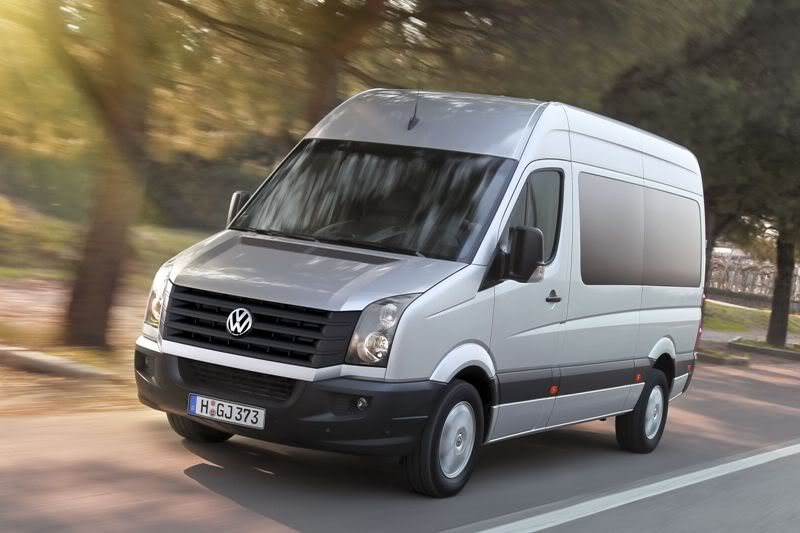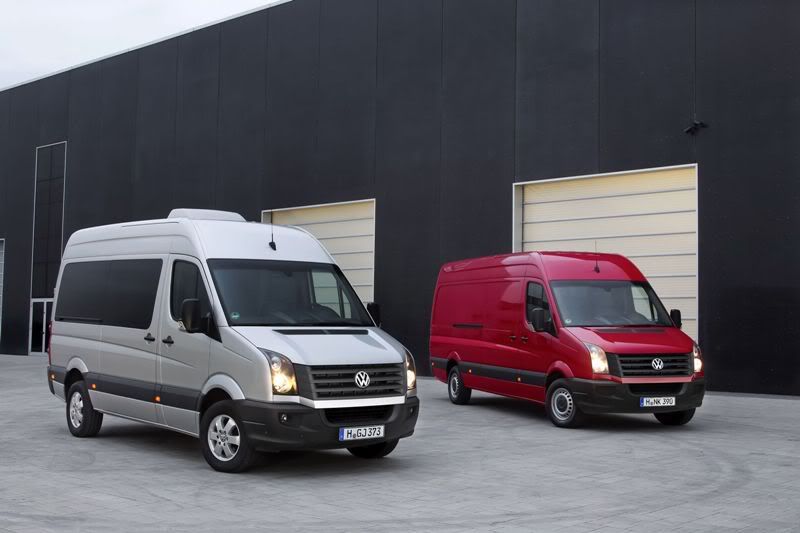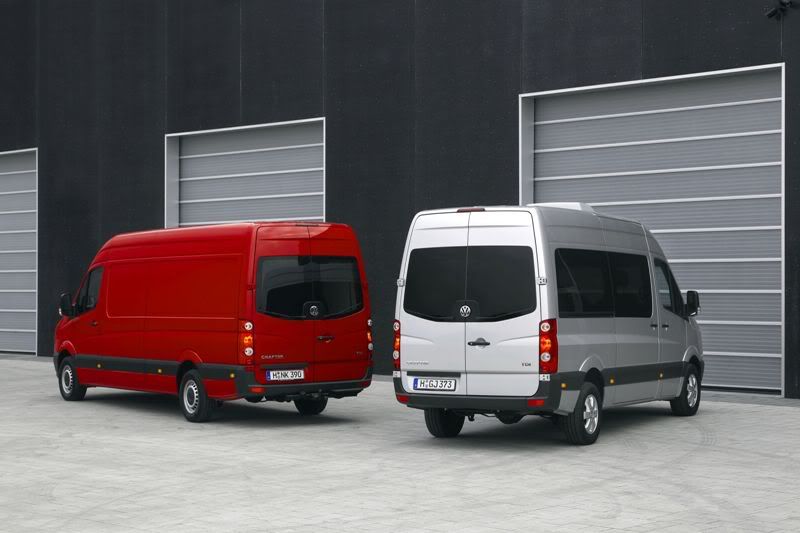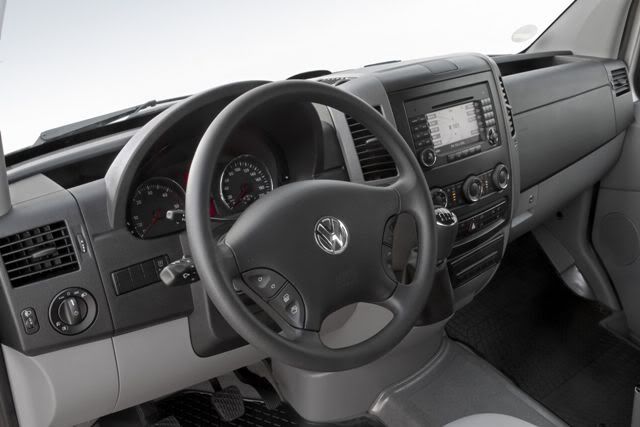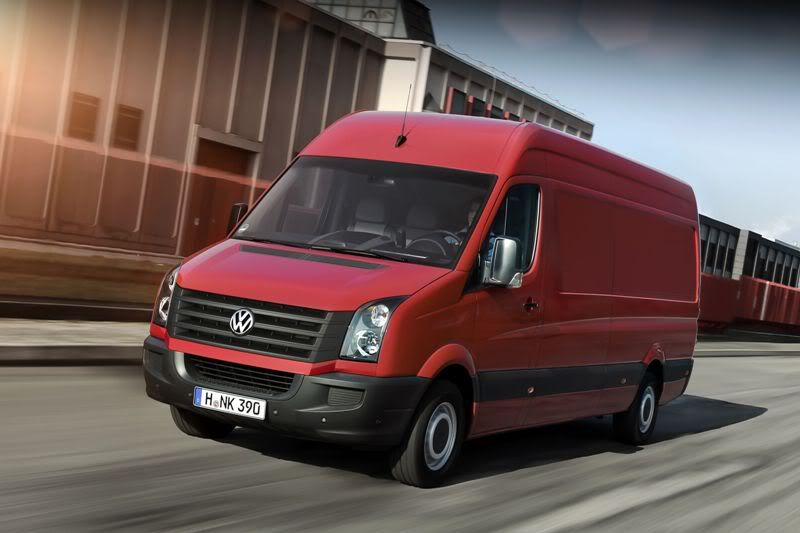
The new Crafter: advanced engines offer more power, better fuel economy and lower operating costs
-Efficient common rail TDI engines with higher torque reduce fuel consumption and CO2 emissions by up to 33percent
-Most fuel-efficient Crafter consumes just 7.2 litres per 100 km
-Up to 25 percent lower operating costs set new standards
Hannover, 06 April 2011 – The Volkswagen Crafter has established itself firmly in the segment of 3.5 tonne transporters. With its new engines, the new Crafter now assumes a top position in key evaluation criteria. Its advanced four-cylinder TDI engines offer significantly better fuel economy and lower operating costs, which are achieved with improved driving performance and higher payloads. In the most powerful new Crafter, a biturbo engine – familiar from the Amarok and the Transporter – outputs a 400 Newton metres of torque for aggressive yet fuel-efficient propulsion.
Visually, the new Crafter essentially follows Volkswagen’s current design philosophy in a redesigned front end emphasising the horizontal lines of its radiator grille and one-piece front facia. This gives the large utility vehicle from Volkswagen Commercial Vehicles a more modern appearance that is in keeping with its brand siblings the Caddy, Amarok and T-series vehicles. The interior was also noticeably upgraded with fresh and durable upholstery fabrics, redesigned instruments and various modifications to feature details.
However, the main upgrades are to be found under the bonnet. The latest generation of powerful and fuel-efficient four-cylinder turbodiesel engines with common rail direct injection now replaces the previous series of five-cylinder engines. The new Crafter does not simply match up to the competition in a significantly more fuel-efficient and powerful form, rather it sets new, contemporary standards in many areas.
Fully updated engine lineup – up to 3.4 litres lower fuel consumption with higher torque
Three power versions – 80, 100 and 120 kW – are available in the new Crafter. All three versions have a 2.0-litre TDI with common rail direct injection from the Group’s modular engine system, which was specially tuned for use in the Crafter.
The entry-level engine, an 80 kW / 109 PS TDI, already offers high performance reserves. Compared to the previous model with the same power, this engine outputs a constant maximum torque over a broader range – from 1,500 rpm to 2,250 rpm.
With this engine, the Crafter’s fuel consumption is just 7.9 litres per 100 km, which is equivalent to CO2 emissions of just 208 g / km.
The Crafter with a 100 kW TDI (136 PS) offers the same fuel economy, but with more power and torque. The maximum torque here is 340 Newton metres, which is already available at 1,600 rpm.
The most powerful, and yet most fuel-efficient version, is the Crafter with a 120 kW TDI engine (163 PS). At a low 1800 rpm, the 2.0-litre biturbo familiar from the Amarok and Transporter already transfers an impressive 400 Newton metres of torque to the drive shaft running to the rear wheels.
The most powerful engine is the most fuel efficient as well; when equipped with the optional engine Stop/Start technology, the Crafter consumes just 7.2 litres of diesel fuel per 100 kilometres, equivalent to CO2 emissions of just 195 g/km.
The introduction of these new engines enables a more harmonious and more economical style of driving; nonetheless, quicker overtaking manoeuvres are possible as well, which significantly improves active safety.
The excellent fuel economy values are enabled by more efficient engines, all of which may be combined with optional BlueMotion Technology starting in the second half of 2011. This includes the engine Stop/Start system with battery regeneration.
With the introduction of this updated engine generation, the new Crafter not only matches up to competitor’s models in terms of fuel economy and torque; rather it sets contemporary standards in many criteria.
In addition to protecting the environment, the primary benefit to the Crafter buyer is lower operating costs – reduced by up to 25 percent. This results from the vehicle’s low fuel consumption and reduced service costs.
Compared to previous engines, the modern four-cylinder engines are not only lighter in weight, they also meet the strict limits of the Euro V emissions standard and fulfil – just as the previous model did – criteria for an EEV vehicle. The EEV standard (Enhanced Environmentally Friendly Vehicle) is currently the most challenging European emissions standard for trucks and buses.
Up to 10 percent more payload
Lighter weight engines and other technical modifications have reduced the kerb weight of all Crafter models, permitting increases in payload by up to ten percent. This is often a crucial factor in daily transport operations.
Auxiliary power take-offs are available from our highly respected conversion partners for all engine versions.
Proven body concept, improved rust protection
The new Crafter is available in numerous versions at its launch: whether as a panel van with three different wheelbases, four length versions and two different roof forms, as a kombi for personal transport, or as a pickup, double cab or a base platform for many different body variants.
The Crafter body not only stands for visual quality, but also for quality in mechanical construction and high standards in manufacturing. Volkswagen’s quality measures include extensive protection against corrosion. All body points at risk for rust corrosion are either single or double galvanised. This applies to all sheetmetal in the water spray area, for example, and to many underbody components. Rust prevention on the new Crafter has been further improved by other galvanising measures as well.
Interior revisions with fresh and durable materials
Along with the updated engine lineup, the passenger compartment of the new Crafter was renewed as well. The Crafter’s reworked interior is characterised by fresh, new materials, and its emblems and the gear shift grip were modified to reflect the new Volkswagen look. Padded surfaces in the doors offer a second arm rest and make driving more relaxed.
The instruments with their more sophisticated design are now easier to read, and all versions include an integrated gear-shift recommendation as standard. This makes it easier to adopt a more fuel-efficient style of driving.
The range of standard features offered in the Crafter is exemplary and extensive.
The new Crafter can be ordered now at all Volkswagen Commercial Vehicles partners; advance ordering has already begun. Prices in Germany begin at 27.410 Euros for the Crafter 30 panel van and at 24.680 Euros for the Crafter 30 chassis cab. First deliveries to customers will be at the end of June.
Volkswagen Financial Services will supplement the two-year manufacturer’s warranty with a one-year extension warranty up to 250,000 kilometres.
